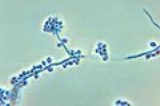
Sporothrix schenckii
Encyclopedia
Sporothrix schenckii is a thermally dimorphic fungus
that can be found world-wide.
The species is present in soil, and in vital and decomposing plant material such as peat moss. Colonies grow moderately rapidly at 25 °C (77 °F). They are moist, leathery to velvety, and have a finely wrinkled surface. The colour is white initially and becomes cream to dark brown in time (“dirty candle-wax” colour). At 37 °C (98.6 °F), colonies are yeast-like and creamy. The colour is cream to beige. The conversion of the mould form to the yeast form is identification of Sporothrix schenckii. Infections due to Sporothrix schenckii are more common at certain geographical areas. Peru
is an area of hyperendemicity for Sporothrix schenckii infections. Sporothrix schenckii is the causative agent of sporotrichosis
or rose-handler's disease. Sporotrichosis is a subcutaneous infection, and it starts following entry of the infecting fungus through the skin via a minor injury (as in penetration by a rose thorn carrying the fungus) and may affect an otherwise healthy individual. Following entry, the infection may spread via the lymphatic route (nodular lymphangitis
may develop). Patients infected with Sporothrix schenckii may be misdiagnosed as pyoderma gangrenosum
due to the large ulcerations observed during the course of sporotrichosis.
(KI) as well as other antibiotic
treatments for superficial fungal infections. KI treatment side effects include extreme gastrointestinal upset.
Thermally dimorphic fungus
Dimorphic fungi are fungi that can reproduce as either a mycelial or a yeast-like state. Generally the mycelial saprotrophic form grows at 25° C, and the yeast-like pathogenic form at 37° C...
that can be found world-wide.
The species is present in soil, and in vital and decomposing plant material such as peat moss. Colonies grow moderately rapidly at 25 °C (77 °F). They are moist, leathery to velvety, and have a finely wrinkled surface. The colour is white initially and becomes cream to dark brown in time (“dirty candle-wax” colour). At 37 °C (98.6 °F), colonies are yeast-like and creamy. The colour is cream to beige. The conversion of the mould form to the yeast form is identification of Sporothrix schenckii. Infections due to Sporothrix schenckii are more common at certain geographical areas. Peru
Peru
Peru , officially the Republic of Peru , is a country in western South America. It is bordered on the north by Ecuador and Colombia, on the east by Brazil, on the southeast by Bolivia, on the south by Chile, and on the west by the Pacific Ocean....
is an area of hyperendemicity for Sporothrix schenckii infections. Sporothrix schenckii is the causative agent of sporotrichosis
Sporotrichosis
Sporotrichosis is a disease caused by the infection of the fungus Sporothrix schenckii. This fungal disease usually affects the skin, although other rare forms can affect the lungs, joints, bones, and even the brain...
or rose-handler's disease. Sporotrichosis is a subcutaneous infection, and it starts following entry of the infecting fungus through the skin via a minor injury (as in penetration by a rose thorn carrying the fungus) and may affect an otherwise healthy individual. Following entry, the infection may spread via the lymphatic route (nodular lymphangitis
Lymphangitis
Lymphangitis is an inflammation of the lymphatic channels that occurs as a result of infection at a site distal to the channel. The most common cause of lymphangitis in humans is Streptococcus pyogenes...
may develop). Patients infected with Sporothrix schenckii may be misdiagnosed as pyoderma gangrenosum
Pyoderma gangrenosum
Pyoderma gangrenosum is a disease that causes tissue to become necrotic, causing deep ulcers that usually occur on the legs. When they occur, they can lead to chronic wounds. Ulcers usually initially look like small bug bites or papules, and they progress to larger ulcers. Though the wounds...
due to the large ulcerations observed during the course of sporotrichosis.
Treatment
The treatment of Sporothrix schenckii includes ingestion of a saturated solution of potassium iodidePotassium iodide
Potassium iodide is an inorganic compound with the chemical formula KI. This white salt is the most commercially significant iodide compound, with approximately 37,000 tons produced in 1985. It is less hygroscopic than sodium iodide, making it easier to work with...
(KI) as well as other antibiotic
Antibiotic
An antibacterial is a compound or substance that kills or slows down the growth of bacteria.The term is often used synonymously with the term antibiotic; today, however, with increased knowledge of the causative agents of various infectious diseases, antibiotic has come to denote a broader range of...
treatments for superficial fungal infections. KI treatment side effects include extreme gastrointestinal upset.

